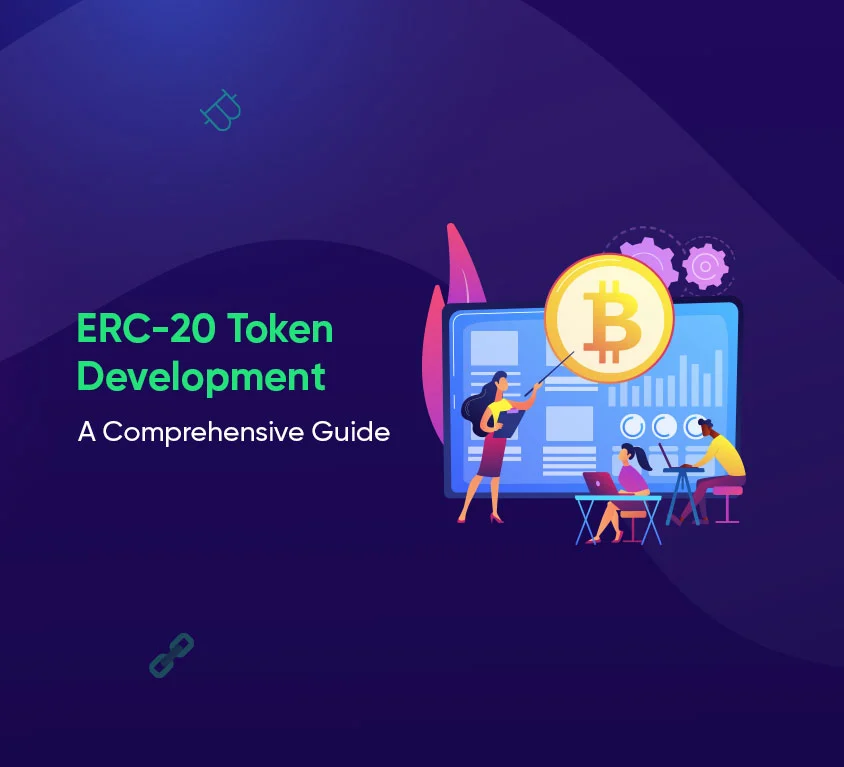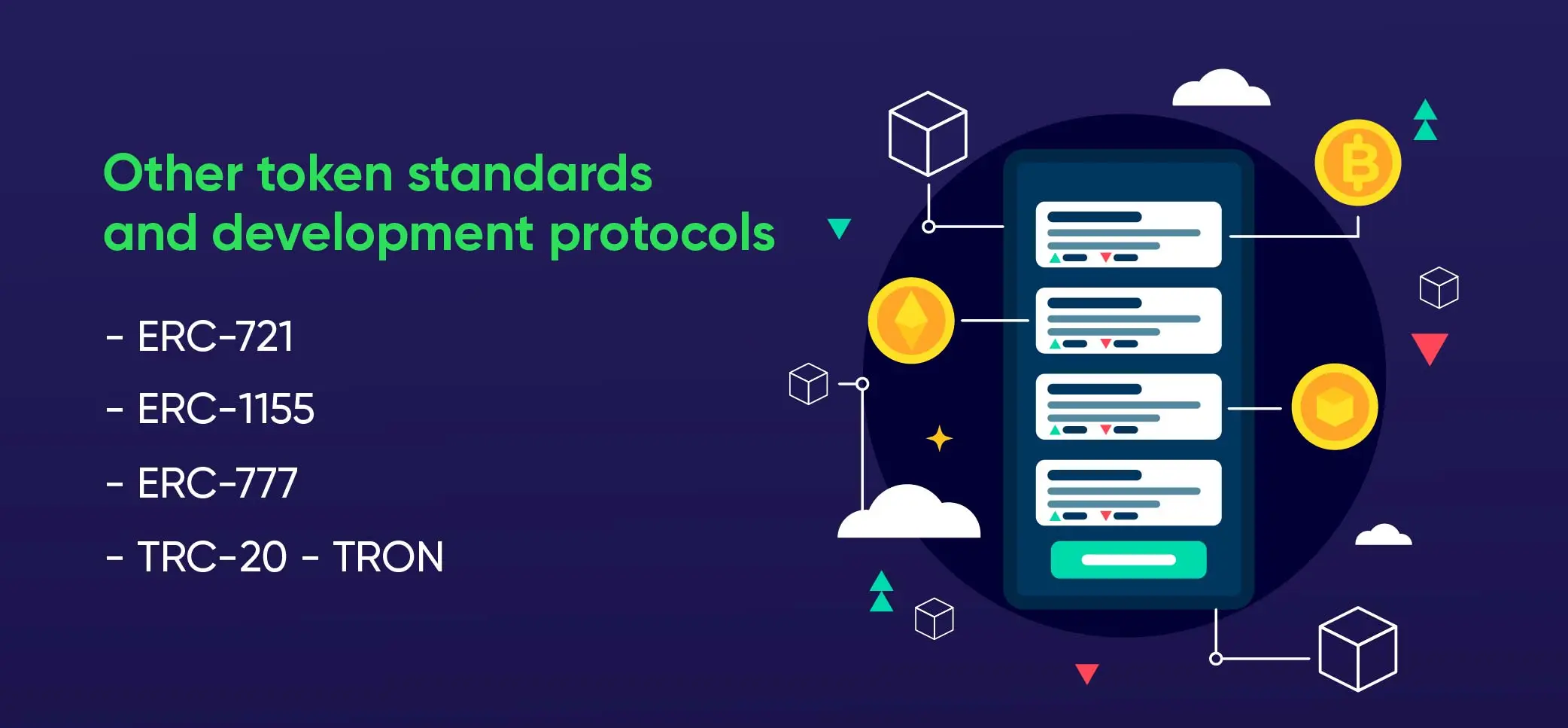
Introduction
Web3 & Blockchain Consultancy :
ERC-20 Token Development: A Comprehensive Guide
In blockchain technology, the creation and management of digital assets have become central. There are a lot of token standards but we are talking about ERC-20 tokens that is a standard on the Ethereum blockchain. This standard has emerged as a cornerstone of this digital revolution. Whether you’re an aspiring blockchain developer, a businessman, an entrepreneur exploring new opportunities, or a crypto investor curious explorer, this blog is your gateway to understanding the ins and outs of ERC-20 token development.What is an ERC-20 Token?
- utility tokens for decentralized applications
- security tokens representing real-world assets

Importance of ERC-20 Standard in Token Development
Is it just a technical specification? No, it’s a catalyst for innovation in the blockchain space and its importance lies in providing a common framework that ensures compatibility and usability. This standardization simplifies the process of creating and managing tokens, providing a great ecosystem of digital assets. Moreover, ERC-20 tokens have become widely accepted and traded in the crypto world, serving as a bridge between diverse projects and facilitating the seamless exchange of value.Difference Between Token and Coin
Aspect |
Token |
Coin |
|---|---|---|
Definition |
Digital assets representing various utilities, assets, or values, are often built on blockchain platforms. | Traditional forms of currency, including physical coins and paper money, are issued and regulated by governments or central banks. |
Digital Nature |
It exists solely in digital form, with no physical representation. | Can be either physical (coins and paper money) or digital (cryptocurrencies). |
Use Cases |
decentralized finance (DeFi), gaming, and digital asset ownership | Medium of exchange for buying goods and services, often used as legal tender |
Examples |
ERC-20 tokens (e.g., DAI, USDT), NFTs (e.g., CryptoKitties) | Bitcoin (BTC), U.S. Dollar (USD), Euro (EUR) |
Developer’s Guide to ERC-20 Token Development
-
Token Details
When creating your smart contract, you’ll specify the token’s name, symbol, and the number of decimal places it uses. These details are important for users to identify and interact with your token.
-
-
Determining Total Supply
-
Deciding the total supply of tokens is significant as it defines the maximum number of tokens that will ever exist. In addition, this number impacts the scarcity and value of your token.
Note: Be thoughtful when determining the token supply, as it’s not easily changed once the contract is deployed.
-
Core Functions for Token Management
The ERC-20 standard includes several core functions.
Implement essential functions like;
- Transfer
- BalanceOf
- Approve
The above-mentioned functions ensure that your token can be easily traded and managed.
- The “transfer” function allows users to send tokens to each other
- The “balanceOf” checks how many tokens a specific address holds.
- The “approve” is used to permit another address to spend tokens on your behalf.
-
-
Custom Functions for Token Enhancement
-
Depending on your token’s specific use case, you can go beyond the standard functions.
For example:
-
-
- You might create a voting function for governance tokens, or develop features for staking tokens to earn rewards.
- In addition, these custom functions add uniqueness and utility to your token, catering to your project’s objectives and user needs.
-
Note: Remember to thoroughly test and document these custom functions to ensure smooth operation.
-
Thorough Testing for Smart Contract Integrity
-
-
Debugging for Code Perfection
-
During the testing phase, issues and bugs may arise. Debugging is the process of identifying, diagnosing, and fixing these errors in the code. It’s a meticulous and iterative process, often involving code reviews and collaboration with other developers.
Continuous refinement of the code ensures that the contract runs smoothly and securely.
-
-
- Deploying Your Smart Contract on Ethereum
-
Once thorough testing is successful, it’s time to deploy the smart contract to the Ethereum blockchain.
This process makes the contract accessible to users and initiates its execution. Deployment is a one-time action and cannot be undone, so careful consideration and final checks are essential.
-
-
- Generating Your Token’s Unique Ethereum Address
-
As the smart contract is deployed, the Ethereum network automatically generates a unique address for your token. This address is essential for users to interact with and trade your token securely. Also, it serves as the identifier for your token within the Ethereum ecosystem. Furthermore, it allows it to be easily recognized and utilized by the Ethereum network and various wallet applications.
Considerations of ERC-20 Token Development
-
Security Measures
To protect your token and its users it is important to ensure that your smart contract is resistant to known vulnerabilities.
Vulnerabilities include;
-
- Reentrancy attacks
- Integer overflows
- Integer underflows
- Unauthorized access
It’s significant to regularly update your code to address new threats as they emerge, staying vigilant to maintain the integrity of your token.
–> It is important to safeguard private keys and contract access
Private keys used to manage the smart contract are the keys to the kingdom. Protect them at all costs. Limit access to these keys to authorized personnel and employ robust access control measures.
Consider using multi-signature wallets, which require multiple parties to sign off on transactions, enhancing the security of your token’s administration.
-
Token Distribution
Token distribution methods;
-
- ICO
- Airdrop
- Pre-sale
Deciding on the distribution method because it can significantly impact its adoption and success.
Consider whether an Initial Coin Offering (ICO), an airdrop to early supporters, or a pre-sale to strategic investors aligns best with your project’s goals and user base. Each method has its own advantages and considerations, and the choice should align with your project’s strategy and objectives.
—> Create a user-friendly interface for participants
A user-friendly interface helps to attract and retain participants. Designing an intuitive and accessible platform or application that allows users to interact with your token seamlessly is essential. A smooth user experience can lead to higher adoption rates and positive user perception, helping your token thrive in a competitive landscape.
-
Understand legal aspects and regulatory compliance
Compliance with local and international regulations can avoid legal issues. In addition, it includes adherence to tax laws, securities regulations, and other financial laws that vary by jurisdiction.
Seek legal counsel if necessary to ensure your token development and distribution are in compliance with the law.
Apply KYC/AML procedures if required
Depending on the regulatory environment and the nature of your token, Know Your Customer (KYC) and Anti-Money Laundering (AML) procedures may be mandated.
Moreso, these measures help verify the identity of token holders and prevent illicit activities, such as money laundering and fraud. Implementing these procedures not only keeps your project compliant but also enhances its trustworthiness in the eyes of regulators and users.
-
Marketing & Token Promotion
Build a community around your token
Token success relies on building a strong community. So, actively engage with your token’s user community through various platforms, including social media, dedicated forums, and participation in blockchain-related events. Also, encourage discussions, answer questions, and create a sense of belonging among your users.
A loyal and active user base not only supports your token’s growth but also helps spread the word and attract new users.
Marketing strategies for token promotion
Create awareness and drive the adoption of your token with different marketing strategies. One should develop comprehensive marketing strategies that encompass both online and offline channels. Then, utilize social media platforms to reach a broad audience, collaborate with influencers and industry experts to build credibility, and form partnerships with related projects to expand your reach. Lastly, marketing campaigns should be well-planned and targeted to maximize the impact of your promotional efforts.
-
Maintenance and Upgrades
Commitment to Support and maintenance
Building trust and maintaining a healthy user experience is a company’s obligation. BloxBytes – a blockchain development company, not only addresses user concerns but checks for technical issues promptly. Regularly monitor the token’s performance, check for anomalies, and maintain clear lines of communication with your community. Ensuring that your token operates smoothly is essential for user satisfaction and long-term success.
Prepare for future upgrades and improvements
It’s essential to plan for future upgrades and improvements to your token to stay competitive and meet evolving user needs. Moreover, it includes adding new features, enhancing security measures, and optimizing performance. This is a must to keep an eye on technological advancements and industry trends to ensure that your token remains relevant and continues to provide value to its users.
Consider regularly engaging with the community to gather feedback and incorporate it into your development roadmap.